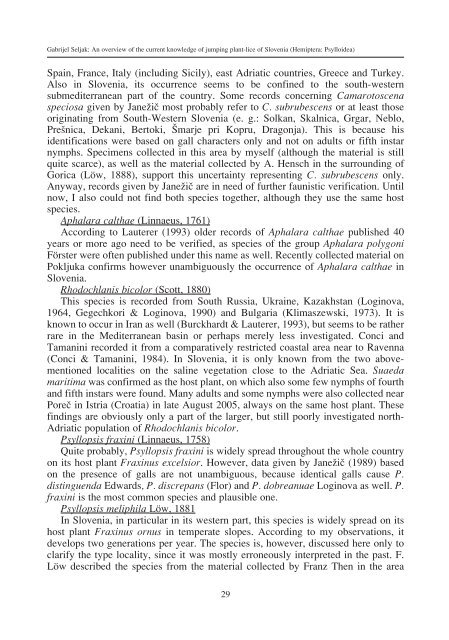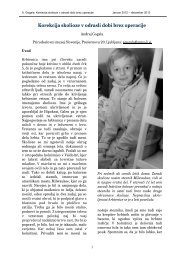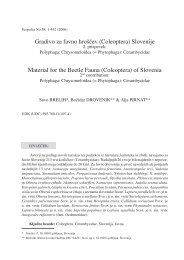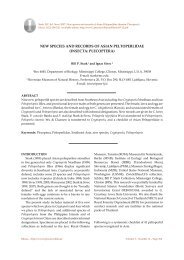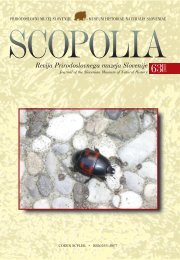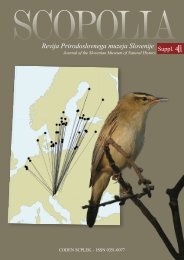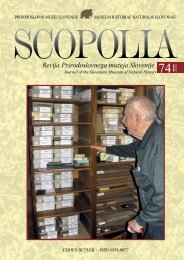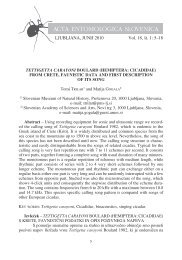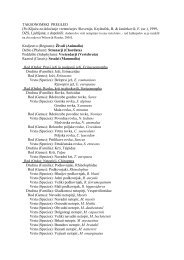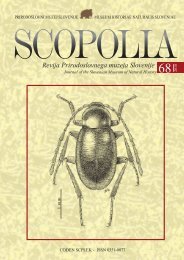Acta entomologica slovenica, 14 (1), 2006GS: Soriøka planina - 1300 m (VM22), 19.08.2002; Logarska dolina (VM73),30.07.2005 on Astrantia carniolica.HP: Astrantia spp. (Apiaceae)Trioza scottii Löw, 1880Löw, 1888: Ømarna gora (VM50)Janeæiœ, 1989: on Berberis vulgaris in 77 localities throughout the wholeterritory;GS: Hotedrøœica (VL38), 10.05.2002; Labinje (VM21), 13.10.2002 and01.11.2003.HP: Berberis vulgaris (Berberidaceae)*Trioza senecionis (Scopoli, 1763)Scopoli, 1763: Carniolia (Slovenia) - terra typica:HP: Senecio nemorensis, S. fuchsii (Asteraceae)Trioza urticae (Linnaeus, 1758)Janeæiœ, 1989: in 86 localities throughout the whole territory;GS: very common and widespread throughout the whole territory, e.g.; Panovec(UL98), 13.09.2000; Nova Gorica (UL99), 14.12.1998; Paljevo (UL99), 20.09.2003;Banjøice - Humarji (UL99), 18.07.2004; Breginj - 550 m (UM72), 22.08.2003; Pl.Na Klinu - 900 m (UM72), 22.08.2003; Podœela (UM83), 16.09.2002; Krn - 1100 m(UM92), 05.07.2003; Lepena - 700 m (UM92), 22.08.2003; Na Skali (UM93) [S.Brelih leg.]; Hruøevica (VL07), 28.04.2002; Matenja vas (VL36), 05.10.2004;Laniøe (VL38), 12.05.2002; Bistra (VL48), 16.06.2004; Sneænik - 1560 m (VL54),21.07.2002; Bevke (VL59), 14.07.2001; Trebnje (VL98), 10.07.2004; Most na Soœi(VM01), 16.08.2003; Æelin (VM10), 25.06.2003; Spodnje Bukovo (VM11),11.03.2001; Zavode (WL37), 10.07.2004; Æadovinek (WL38), 10.07.2004; GornjePijavøko (WL39), 01.05.2003; Jareninski dol (WM56), 25.07.2004; Mestni vrh priPtuju (WM64), 22.07.2003; Strezetina (WM84), 20.06.2003; Strezetina (WM84),22.07.2003; Litmerk (WM84), 15.08.2004; Mali Brebrovnik (WM94), 22.07.2003;Œentiba (XM15), 27.07.2004.HP: Urtica dioica, U. urens (Urticaceae)Trioza velutina Foerster, 1848GS: Orlek - 345 m (VL05), 19.06.2005; Lokvica - 215 m (UL97), 08.05.2005;Ajøevica (UL98), 22.04.2004; Nova Gorica (UL99), 11.04.2004 and 18.06.2005;Podsabotin (UL99), 19.05.2004; Økabrijel (UL99), 04.06.2004; Œrniøke Ravne(VL08), 03.07.2004; Pri peœi (VL09), 12.07.2002 and 02.05.2004; Socerb (VL14),30.05.2004; Œrnotiœe (VL14), 30.05.2004; Nanos - 1040 m (VL27), 16.07.2004;Godoviœ (VL38), 10.05.2002; Hruøica (VL38), 30.05.2002; Labinje 800 m (VM21),23.08.2004.HP: Galium spp. (Rubiaceae)Comments on some critical or less known speciesCamarotoscena speciosa (Flor, 1861) and C. subrubescens (Flor, 1861)According to Conci & al. (1993) the distribution of Camaratoscena subrubescensis limited to warm regions of the Mediterranean northern side. It is recorded from28
Gabrijel Seljak: An overview of the current knowledge of jumping plant-lice of Slovenia (Hemiptera: Psylloidea)Spain, France, Italy (including Sicily), east Adriatic countries, Greece and Turkey.Also in Slovenia, its occurrence seems to be confined to the south-westernsubmediterranean part of the country. Some records concerning Camarotoscenaspeciosa given by Janeæiœ most probably refer to C. subrubescens or at least thoseoriginating from South-Western Slovenia (e. g.: Solkan, Skalnica, Grgar, Neblo,Preønica, Dekani, Bertoki, Ømarje pri Kopru, Dragonja). This is because hisidentifications were based on gall characters only and not on adults or fifth instarnymphs. Specimens collected in this area by myself (although the material is stillquite scarce), as well as the material collected by A. Hensch in the surrounding ofGorica (Löw, 1888), support this uncertainty representing C. subrubescens only.Anyway, records given by Janeæiœ are in need of further faunistic verification. Untilnow, I also could not find both species together, although they use the same hostspecies.Aphalara calthae (Linnaeus, 1761)According to Lauterer (1993) older records of Aphalara calthae published 40years or more ago need to be verified, as species of the group Aphalara polygoniFörster were often published under this name as well. Recently collected material onPokljuka confirms however unambiguously the occurrence of Aphalara calthae inSlovenia.Rhodochlanis bicolor (Scott, 1880)This species is recorded from South Russia, Ukraine, Kazakhstan (Loginova,1964, Gegechkori & Loginova, 1990) and Bulgaria (Klimaszewski, 1973). It isknown to occur in Iran as well (Burckhardt & Lauterer, 1993), but seems to be ratherrare in the Mediterranean basin or perhaps merely less investigated. Conci andTamanini recorded it from a comparatively restricted coastal area near to Ravenna(Conci & Tamanini, 1984). In Slovenia, it is only known from the two abovementionedlocalities on the saline vegetation close to the Adriatic Sea. Suaedamaritima was confirmed as the host plant, on which also some few nymphs of fourthand fifth instars were found. Many adults and some nymphs were also collected nearPoreœ in Istria (Croatia) in late August 2005, always on the same host plant. Thesefindings are obviously only a part of the larger, but still poorly investigated north-Adriatic population of Rhodochlanis bicolor.Psyllopsis fraxini (Linnaeus, 1758)Quite probably, Psyllopsis fraxini is widely spread throughout the whole countryon its host plant Fraxinus excelsior. However, data given by Janeæiœ (1989) basedon the presence of galls are not unambiguous, because identical galls cause P.distinguenda Edwards, P. discrepans (Flor) and P. dobreanuae Loginova as well. P.fraxini is the most common species and plausible one.Psyllopsis meliphila Löw, 1881In Slovenia, in particular in its western part, this species is widely spread on itshost plant Fraxinus ornus in temperate slopes. According to my observations, itdevelops two generations per year. The species is, however, discussed here only toclarify the type locality, since it was mostly erroneously interpreted in the past. F.Löw described the species from the material collected by Franz Then in the area29
- Page 1: Vsebina / ContentsL. SENŒIŒ: Inte
- Page 4: ISSN 1318-1998CODEN: AESLFMUDC (UDK
- Page 7 and 8: ACTA ENTOMOLOGICA SLOVENICALJUBLJAN
- Page 9 and 10: Leon Senœiœ: Intensity of wing pi
- Page 11 and 12: Leon Senœiœ: Intensity of wing pi
- Page 13 and 14: ACTA ENTOMOLOGICA SLOVENICALJUBLJAN
- Page 17 and 18: Gabrijel Seljak: An overview of the
- Page 19 and 20: Gabrijel Seljak: An overview of the
- Page 21 and 22: Gabrijel Seljak: An overview of the
- Page 23 and 24: Gabrijel Seljak: An overview of the
- Page 25 and 26: Gabrijel Seljak: An overview of the
- Page 27 and 28: Gabrijel Seljak: An overview of the
- Page 29: Gabrijel Seljak: An overview of the
- Page 33 and 34: Gabrijel Seljak: An overview of the
- Page 35 and 36: Gabrijel Seljak: An overview of the
- Page 37 and 38: ACTA ENTOMOLOGICA SLOVENICALJUBLJAN
- Page 39 and 40: Bojan Kofler: Anophthalmus miroslav
- Page 41 and 42: Bojan Kofler: Anophthalmus miroslav
- Page 43 and 44: Bojan Kofler: Anophthalmus miroslav
- Page 45 and 46: ACTA ENTOMOLOGICA SLOVENICALJUBLJAN
- Page 47 and 48: Tone Lesar, Matjaæ Jeæ: Prispevek
- Page 49 and 50: Tone Lesar, Matjaæ Jeæ: Prispevek
- Page 51 and 52: Tone Lesar, Matjaæ Jeæ: Prispevek
- Page 53 and 54: Tone Lesar, Matjaæ Jeæ: Prispevek
- Page 55 and 56: Tone Lesar, Matjaæ Jeæ: Prispevek
- Page 57 and 58: ACTA ENTOMOLOGICA SLOVENICALJUBLJAN
- Page 59 and 60: Ivana Æiviå, Zoran Markoviå, Mil
- Page 61 and 62: Ivana Æiviå, Zoran Markoviå, Mil
- Page 63 and 64: Ivana Æiviå, Zoran Markoviå, Mil
- Page 65 and 66: Ivana Æiviå, Zoran Markoviå, Mil
- Page 67 and 68: Ivana Æiviå, Zoran Markoviå, Mil
- Page 69 and 70: Ivana Æiviå, Zoran Markoviå, Mil
- Page 71 and 72: ACTA ENTOMOLOGICA SLOVENICALJUBLJAN
- Page 73 and 74: Ljiljana Protiå: Nabidae (Heteropt
- Page 75 and 76: Ljiljana Protiå: Nabidae (Heteropt
- Page 77 and 78: Ljiljana Protiå: Nabidae (Heteropt
- Page 79 and 80: Ljiljana Protiå: Nabidae (Heteropt
- Page 81 and 82:
Ljiljana Protiå: Nabidae (Heteropt
- Page 83 and 84:
ACTA ENTOMOLOGICA SLOVENICALJUBLJAN
- Page 85 and 86:
M Aydogdu, A. Beyarslan: First reco
- Page 87 and 88:
M Aydogdu, A. Beyarslan: First reco
- Page 89 and 90:
M Aydogdu, A. Beyarslan: First reco
- Page 91 and 92:
ACTA ENTOMOLOGICA SLOVENICALJUBLJAN
- Page 93 and 94:
Emine Demir: Preliminary report on
- Page 95 and 96:
Emine Demir: Preliminary report on
- Page 97 and 98:
Emine Demir: Preliminary report on
- Page 99 and 100:
Emine Demir: Preliminary report on
- Page 101 and 102:
Emine Demir: Preliminary report on
- Page 103 and 104:
Emine Demir: Preliminary report on
- Page 105 and 106:
Favnistiœni zapiski / Faunistical
- Page 107 and 108:
Abdullah Hasbenli, Fatma Bayrakdar,
- Page 109 and 110:
Vabilo na Prvi slovenski entomoloø


